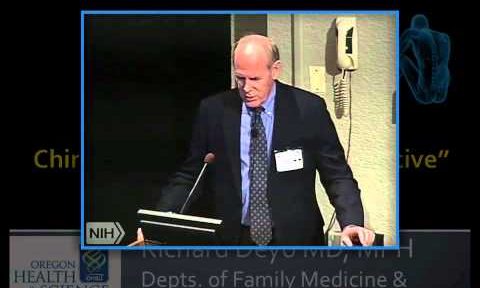Good morning, everyone. My name is David Shurtleff. I’m the Deputy Director for NCCAM, and it’s my pleasure this morning to welcome and introduce Dr. Richard Deyo as our speaker for NCCAM’s second integrative medicine lecture for 2014. Dr. Deyo is the Kaiser Permanente Professor of Evidence-Based Family Medicine in the Department of Family Medicine at Oregon Health and Sciences University, Portland, Oregon. Before joining OHSU in 2007, Dr. Deyo was the Co-Director, Center for Cost and Outcomes Research at the University of Washington, Seattle. Dr. Deyo has a longstanding interest and is a recognized leader in research in the study of the clinical interventions and treatment of back pain.
He has published extensively on the topic, with over 300 publications, and has been a member of the Federally funded panel that wrote guidelines for the care of acute low-back pain problems, and he is currently deputy editor of the journal Spine. So, as we all know, according to the IOM, chronic pain affects approximately 100 million American adults–more than the total affected by heart disease, cancer, and diabetes combined. Pain also costs the nation up to $635 billion each year in medical treatment and lost productivity. So, clearly a huge public-health crisis we face in thinking about and treating pain. So today Dr. Deyo will present his research that has examined complementary health care approaches such as massage and acupuncture for the treatment of back pain, and the title of his presentation is “Manipulating the Pain: Chiropractic and Other Alternative Treatments for Back Pain.” So please welcome Dr.
Deyo. DR. RICHARD A. DEYO: Well, thank you and good morning. It’s really a pleasure and a privilege for me to be here. I appreciate the invitation to come and talk a little bit about the research that we’ve been doing in the great Pacific Northwest having to do with a variety of treatments for chronic back pain but complementary and alternative treatments in particular. I thought what I would do is spend a couple of slides just talking about what I think are some of the sources of the mistrust and skepticism that mutually exists between complementary and alternative practitioners and the regular medical profession.
I’ll talk then about some of the methodologic challenges that we faced in trying to study complementary and alternative treatments. And then I’ll go into a discussion of some of the randomized trials that we’ve done in Seattle, primarily with my colleagues at Group Health Cooperative, that have focused on chiropractic care, acupuncture, and massage, which are in fact the most common complementary and alternative treatments for back pain. And then I’ll talk a little bit about some of the cost implications at least of these kinds of treatments.
The origins of chiropractic go back to the late 1800s when D. D. Palmer, who was a magnetic healer in the Midwest, claimed to have cured a janitor’s deafness by manipulating his neck. Palmer subsequently went on to coin the term “chiropractic”, dealing with therapy by hand, and he founded the first school of chiropractic in 1897. Palmer and the early chiropractors came to believe that 95 percent of all diseases were caused by misaligned vertebrae. And as a result, they actually rejected the germ theory, and a consequence of that of course was that they rejected the notion of vaccines and drugs and so forth, and basically were rejecting a lot of the emerging science that I think now is well accepted. Even today, you see what some would consider to be extravagant claims for treating things like congestive heart failure or diabetes by chiropractic manipulation, and I’m going to avoid that argument and just focus on back pain, which is really still the most common problem that’s addressed by chiropractors. The animosity between the conventional medical world and the chiropractic world probably peaked in the 1960s when the American Medical Association formed a Committee on Quackery that was really largely devoted to eliminating the chiropractic profession.
And in turn, the JAMA editor at the time was dubbed by the chiropractors a “medical Mussolini” for his efforts to try to eliminate chiropractic. So you can appreciate there was plenty of ill will to go around, and I’d argue that’s changed substantially over the last 10 or 20 years. The origins of acupuncture go back much, much further. Maybe 1000 B.C. are the first records that we have of something that looks like acupuncture probably in China.
It was postulated that there were these meridians with a flow of life energy that existed and are depicted in illustrations like this one. But there’s really been no known anatomical basis for these meridians. Nonetheless, acupuncture surged in popularity after Nixon visited China in 1972 and had acupuncture demonstrated for him. And again, there are sometimes claims that seem to many extravagant, such as major open-heart surgery being done just under acupuncture anesthesia, a claim that apparently has been substantially exaggerated. .
